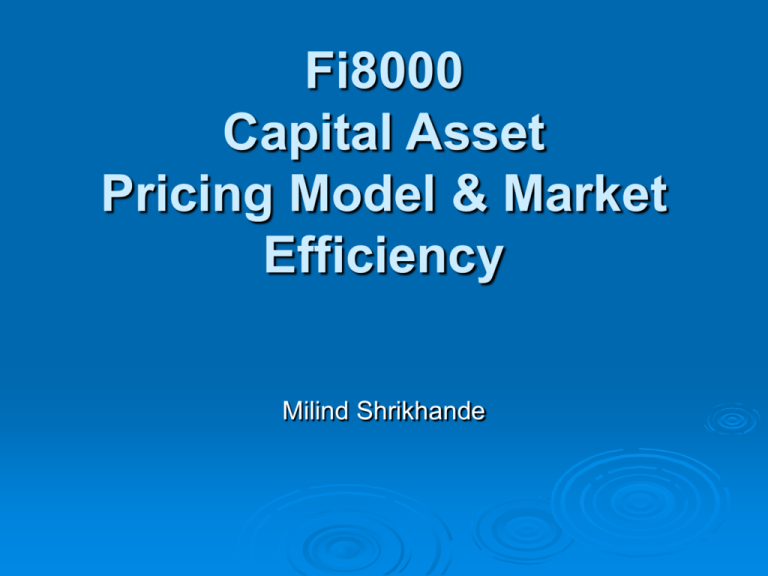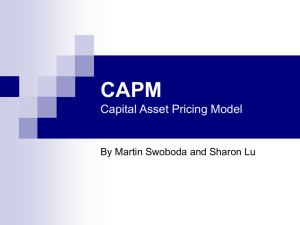Fi800 Valuation of Financial Assets
advertisement

Fi8000
Capital Asset
Pricing Model & Market
Efficiency
Milind Shrikhande
Today
☺
The Capital Asset Pricing Model
☺
Market Efficiency
The Capital Asset Pricing Model
☺
Sharp (1968), Black (1969) and
Lintner (1970)
☺
A model that tells us the fair (riskadjusted) expected return for every
individual asset
☺
A market equilibrium model
The Capital Asset Pricing Model
(CAPM): Outline
☺
The assumptions of the model
☺
The market equilibrium: SML equation
☺
The two components of risk:
☺
☺
Systematic (non-diversifiable)
Non-systematic (diversifiable)
☺
Beta as a measure of systematic risk
☺
The returns and the prices of risky assets
The Capital Asset Pricing Model
(CAPM): Assumptions
☺
There are many investors – each investor is a
price taker
☺
All investors plan for one identical holding
period
☺
All risky assets are publicly traded
☺
All investors are risk-averse and Mean-Variance
optimizers
☺
Homogeneous expectations - all investors have
the same information and interpret it the same
way
The CAPM: Assumptions
☺
The perfect market assumption
☺
☺
☺
☺
There are no taxes or transaction costs or
information costs
There are no frictions
Stocks can be bought and sold in any
quantity (even fractions)
There is one risk-free asset and all investors
can borrow or lend at that rate
The CAPM: Market Equilibrium
The market portfolio (m) is on the efficient frontier
and on the CML. It is the Mean-Variance optimal
portfolio of risky assets.
All the investors will invest in the same portfolio of
risky assets: m - the market portfolio.
The proportion of each asset in the market
portfolio is simply the asset’s market value divided
by the total wealth (market value of all assets).
The Market Portfolio
in the μ-σ Plane
μ
The Capital Market Line:
m
rf
μp= rf+[(μm-rf) / σm]·σp
The CAPM: Market Equilibrium
The risk preferences of the investors will
result in their capital allocation between the
market portfolio and the risk-free asset – i.e.
the location of their portfolio on the Capital
Market Line (CML).
(The mutual fund theorem)
Passive Investment Strategies
in the μ-σ Plane
The CML:
μ
μp= rf + [(μm-rf) / σm]·σp
m
p
rf
q
The CAPM: Market Equilibrium
The risk premium of each risky assets will be
proportional to the risk premium of the market
portfolio and to the beta coefficient of the risky
asset:
i rf m rf i
The Capital Asset Pricing Model:
The Security Market Line (SML)
μ
The SML:
q
μi= rf+ [μm-rf]·βi
m
p
rf
What is Beta?
☺
Beta is a measure of risk
☺ Beta measures how sensitive are the returns
of asset i to the returns of the market
portfolio
☺ Beta is the slope (coefficient) in the
regression of asset i’s return (risk premium)
on the market’s return (market risk premium)
☺ Beta is a relative measure of risk
· Beta < 1 : defensive asset
· Beta = 1: neutral asset
· Beta > 1: aggressive asset
Beta
Ri-rf
βi
Calculating Beta
im i im
i 2
m
m
The CAPM Market Equilibrium:
Outline of the Proof
☺
The risk-free asset is on the SML
☺
☺
The market portfolio is on the SML
☺
☺
Calculate the beta of the market portfolio
Any M-V efficient portfolio p is on the SML
☺
☺
Calculate the beta of the risk-free asset
Calculate the beta of an efficient portfolio
Any risky asset i is on the SML
The Benefits of Diversification
σp
Diversifiable Risk
Systematic Risk
The Risk
☺
The risk of any risky asset has two components
☺
☺
☺
σD - The diversifiable (non-systematic, idiosyncratic,
firm-specific) risk can be eliminated by adding
assets to the portfolio
σND - The systematic (non-diversifiable, market) risk
can not be eliminated through diversification
According to the CAPM, investors are
compensated only for the systematic
component of the total asset risk (σND).
The Components of Risk
in the μ-σ Plane
The CML
μ
m
p
i
rf
σND
σD
σ
The CAPM Market Equilibrium
Find beta in the following planes
Ri-Rm or (Ri-rf) – (Rm-rf)
μ-σ (the CML)
μ-β (the SML)
The CAPM: Market Equilibrium
μ
SML
Underpriced – return is too high
m
Overpriced – return is too low
rf
The Return and the Current Price:
Inversely Related
E R k
E P1 Div1
P0
1
A and B are two risky stocks. An analyst found that they
have the following parameters:
μA=15% and βA=0.5;
μB=22% and βB=2.
The risk-free rate is rf=10% and the expected return of the
market portfolio is μm=18%.
Relative to the CAPM equilibrium prices, which stock is
underpriced and which is overpriced?
Project Valuation – Example 1
Firm XYZ usually invests in projects with a risk level of
β=0.8. It is considering an investment in a new project
which is expected to produce a CF of $12.6M a year
from now, and this CF is expected to grow at a
constant rate of 2% per year forever. This CF is only
an expectation and the firm’s economist estimates it’s
Std to be $3M.
What is the present value of the CFs of this project, if
the expected annual return of the market portfolio is
12%, the annual return of money market instruments is
4% and the market is in equilibrium (CAPM)?
(k = 10.4%; PV = $150M)
Project Valuation – Example 2
Joseph is looking for a treasure ship in the Mediterranean
sea. He plans to keep looking for a year, and at the end of
that year the value of his firm will be determined by the
outcome of his quest. The probability of finding the $25M
treasure is only 10% but he is more likely to end up with a
smaller catch of only $5M.
Obviously, the outcome of Joseph’s quest is independent of
any macroeconomic risks, but we know that the expected
annual return of the market portfolio is 14%, it’s Std is 22%
and the annual return of money market instruments is 6%.
What is the value of Joseph’s firm if the market is in
equilibrium (CPAM)?
(PV = $6.604M)
CAPM Review
Under strict assumptions, the CAPM results
in a prescription for a fair return (price):
The fair expected return on an asset
depends on the market risk premium and
on beta.
Stocks with high betas have higher return,
but there is no compensation for any risk
factor other than the systematic market risk.
CAPM Critique
☺Roll
(1977) points out that the CAPM is not
directly testable
It is a one period model
☺ The market portfolio cannot be identified
☺To test the model, we need the market portfolio to be
on the “efficient frontier” (proxies won’t work)
☺
☺Indirect
☺
tests fail to support the CAPM
Other risk factors are compensated (size, book-tomarket ratio), but there is no theoretical explanation for
these risk factors.
The Efficient Market Hypothesis
☺The
Efficient Markets Hypothesis (EMH)
specifies three forms of efficiency:
Weak form market efficiency
☺ Semi-Strong form market efficiency
☺ Strong form market efficiency
☺
☺Note
that EMH is an Hypothesis
We should look for evidence that reject the hypothesis
☺ We should look for evidence to decide which form of
EMH is more likely
☺
Weak Form Efficiency
☺Definition:
A market is weak form efficient if the current
asset prices reflect all historical price
information
☺Implication:
Trading strategies based on the analysis of
historical prices should not yield abnormal
returns (on average!)
Normal and Abnormal Returns
☺Normal
returns:
Fair or equilibrium returns given by a
theoretical model like the CAPM
☺Abnormal
returns:
Returns that are systematically higher than the
normal returns
Normal and Abnormal Returns
☺ For
each asset i the CAPM predicts a normal, riskadjusted rate of return (expected return):
E(Ri) = rf + βi [ E(Rm) – rf ]
☺ We
observe asset i over time, and compare the realized
return Ri to the expected CAPM return:
αit = Rit – E(Ri) = Rit – { rf + βi [ E(Rmt) – rf ] }
☺ If
asset i is systematically beating the CAPM expected
return, we say that the return of asset i is abnormal.
Abnormal return: Average[ αit ] = 1/T [αi1 + αi2 +…+ αiT] > 0
Semi-Strong Form Efficiency
☺Definition:
A market is semi-strong form efficient if the
current asset price reflects all publicly available
information
☺Implication:
Trading strategies based on the analysis of
publicly available information (fundamental
analysis such as analyst reports) should not
yield abnormal returns (on average!)
Strong Form Efficiency
☺Definition:
A market is strong form efficient if the current
asset price reflects all information (including
private / insider information)
☺Implication:
There is no (legal) trading strategy that yields
abnormal returns (on average!). One cannot
make money even by following the trades of
insider information.
Nesting
☺Information:
Information about past prices is included in the
set of publicly available information, which is
included in the complete set of information.
☺Market
efficiency:
The strong form of market efficiency implies the
semi-strong, which implies the weak form. Note
that the strongest form of the MEH is the
strongest and the most restricting assumption.
Evidence of Weak Form MEH
☺Consistent
evidence:
Technical trading rules, based on past price
patterns, do not appear to be profitable.
☺Contradicting
evidence:
The “January” effect – almost every January,
stock returns (usually for small stocks) are
positive.
Evidence of
Semi-Strong Form MEH
☺Consistent
evidence:
New publicly available information (such as earnings
release) affects prices quickly.
☺Contradicting
evidence:
Small stocks and stocks with high ratio of book-value to
market-value have, on average, higher returns.
Some portfolio managers consistently outperform the
market (Peter Lynch, Warren Buffet, John Templeton
and John Neff are in Paul Samuelson’s hall of fame,
1989).
Evidence of Strong Form MEH
☺Consistent
evidence:
Insiders of corporations appear able to earn abnormal
returns from their trades. On average, price increases
just after insiders purchase the stock and decreases
just after a they sell the stock.
☺Contradicting
evidence:
Prices react to public information that had been private.
For example, prices react to earning announcements
even though someone must have know their contents
before the official announcement day.
Market Efficiency and Equilibrium
☺An
efficient market is a market in
equilibrium
☺Inefficient
markets occur when asset
prices are different from their equilibrium
prices
☺In
theory, traders who exploit market
inefficiencies should move the market back
to equilibrium
The Joint Hypothesis Problem
☺A test
of market efficiency can only be
conducted by using a theoretical model to
define normal (fair) returns (prices)
☺Finding
an abnormal average return can
be interpreted in more than one way:
Reject the Market Efficiency Hypothesis (MEH)
☺Reject the theoretical model of normal returns
☺Reject both
☺
MEH – Are Markets Efficient?
☺ Grossman
and Stigliz (1980): the logical question must
always be to what extent markets are efficient
☺ Empirical
evidence
☺ Implications for trading strategies?
☺Technical analysis
☺Fundamental analysis
☺Trading on insider information (SEC regulations)
☺ Is
there a portfolio manager who systematically
outperforms the market?
Is a small abnormal return detectable?
☺Will they tell us about their winning strategy (selection bias)?
☺How can we distinguish between luck and talent?
☺
Practice Problems
BKM Ch. 9: 1-2, 4-17, 21-28
BKM Ch. 12: 1-9, 14, 16-18, 25, 27-28






